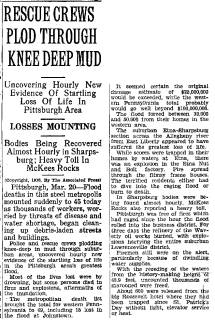Collection Name
About
RESCUE CREWS PLOD THROUGH KNEE DEEP MUD
Uncovering Hourly New Evidence Of Startling Loss Of Life In Pittsburgh Area
LOSSES MOUNTING
Bodies Being Recovered Almost Hourly in Sharpsburg; Heavy Toll In McKees Rocks
Pittsburgh, Mar. 20—Flood deaths in this steel metropolis mounted suddenly to 45 today as thousands of workers, worried by threats of disease and water shortage, began cleaning up debris-laden streets and buildings.
Police and rescue crews plodding knee-deep in mud through suburban areas, uncovered hourly new evidence of the startling loss of life in the Pittsburgh area's greatest flood.
Most of the lives lost were by drowning, but some persons died in fires and explosions, aftermaths of the inundation.
The metropolitan death list brought the total for western Pennsylvania to 69, including 15 lost in the flood at Johnstown.
It seemed certain the original damage estimate of $25,000,000 would be exceeded, while the western Pennsylvania total probably would go well beyond $100,000,000.
The flood forced between 30,000 and 50,000 from their homes in the western area.
The suburban Etna- Sharpsburg section across the Allegheny river from East Liberty appeared to have suffered the greatest loss of life.
While scores were trapped in their homes by waters at Etna, there was an explosion in the Etna Nut and Bolt factory. Fire spread through the flimsy frame houses. The terrified residents either had to dive into the raging flood or burn to death.
In Sharpsburg bodies were being found almost hourly. McKees Rocks also reported a heavy toll.
Pittsburgh was free of fires which had raged since the hour the flood rolled into the business district. For three days the refinery of the Waverly oil works burned, with explosions harrying the entire suburban Lawrenceville district.
Firemen still were on the alert, particularly because of dwindling water supplies.
With the receding of the waters from the history-making height of 45.9 feet, uncounted thousands of marooned were freed.
About 600 were released from the big Roosevelt hotel where they had been trapped since St. Patrick's Day without light, elevator service or heat.
